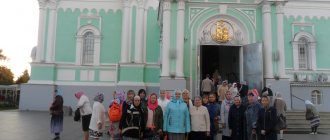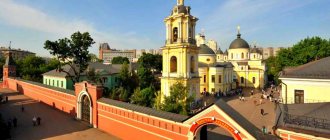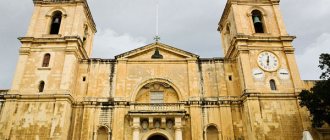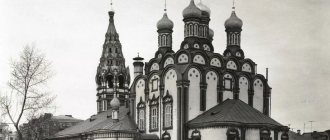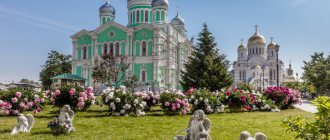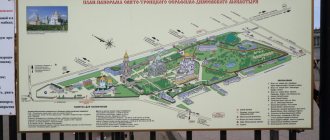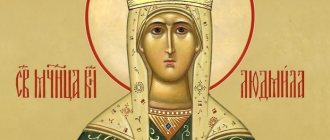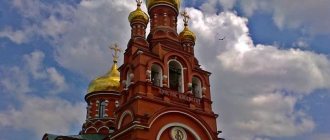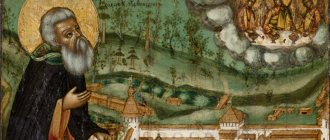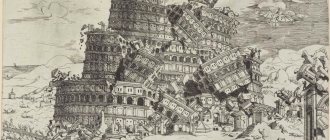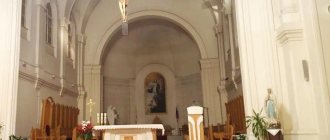Right hand Joanna Baptist - the incorruptible right hand of the holy prophet John the Baptist. One of the most revered shrines in the Christian world, since according to the Bible, John the Baptist laid his right hand on the head of Jesus Christ during Baptism.
After the beheading of the head of the Forerunner, his body was buried in Samaria and remained incorrupt. According to legend, the evangelist Luke, passing through Samaria and preaching the Savior, wanted to transfer the body of John the Baptist to his homeland in Antioch, but, having received a refusal from the inhabitants of Samaria, he took only the right hand, that is, the right hand that baptized Christ in the Jordan.
In Antioch, the honorable right hand of John the Baptist was preserved for several centuries, surviving the times of Julian the Apostate, who sought in vain to destroy it.
The Hand and the “Miracle of the Serpent”
There is a legend associated with this relic, reminiscent of fairy tales about a dragon and a beautiful girl: supposedly in the vicinity of Antioch there lived a terrible serpent, to which the pagans sacrificed an innocent girl every year. One day the lot fell on the daughter of a Christian who came to pray before the right hand of the Baptist for salvation. He deliberately took with him several gold coins and made them seem to scatter by accident. While the guard guarding the shrine was picking up coins and putting them in his pockets, the loving father secretly bit off the little finger from the wonderful right hand and hid it in himself. The next day, he and his daughter, half dead from fear, went out to meet the monster, and when the snake opened its mouth, he threw his little finger into it. Need I say that the monster immediately fell lifeless, and the right hand of the Baptist was glorified more than before, enriching its history with the “Miracle of the Serpent”?
When Antioch was captured by the Turks, a certain deacon with the biblical name Job secretly took the relic to Constantinople, where it remained, surrounded by honor, for another five centuries. When the capital of Byzantium also fell under the Turkish yoke, the right hand of the Baptist continued to remain in the Church of Hagia Sophia, converted into a mosque.
Fatal dance
John the Baptist, born in Judea (only six months earlier than Jesus Christ), was forced to spend most of his life in the desert. It just so happened that his father, the high priest Zechariah, somehow angered King Herod the Great and was killed by the ruler’s servants right in the Jerusalem temple , and his wife and newborn son simply miraculously managed to escape from the city. However, soon John’s mother also died, and the boy was left completely alone. In the desert, the saint led an ascetic lifestyle. His food was wild honey and dried locusts, and his clothes were replaced by scraps of camel skins When John was thirty years old, he settled in a small hut near the Jordan River, where he preached to people about the imminent coming of the Messiah - the Savior of the human race - and baptized those who believed in the waters of the stream. Here, shortly before the arrest of the Forerunner, the Savior himself came, wishing to accept from John the sacred sacrament At that time, Judea was ruled by King Herod Antipas, a protégé of the Roman emperor, a tyrant who placed himself above all laws. Not caring about the principles of morality, this tyrant took his wife Herodias from his brother, whom he placed on the throne next to him, to the great indignation of his subjects. And only John the Baptist dared to openly condemn the behavior of the ruler and vehemently denounced royal depravity in his fiery sermons. Retribution was not long in coming, and soon the saint was arrested and thrown into prison. However, Herod Antipas did not dare to execute John for a long time. He feared that the death of his beloved preacher would cause popular unrest, from which even the legionnaires of the Roman governor would not protect him. But Queen Herodias decided by any means to achieve the death of the ragged tramp who dared to talk nasty things about her. And a “happy” chance helped her with this. At the ruler's birthday, her daughter Salome performed a fiery dance, which Herod really liked. The pleased king promised to fulfill any desire of his stepdaughter, and she, at the instigation of her mother, asked him for the head of John the Baptist. Since the promise was made in the presence of high-ranking guests, Herod did not dare to go back on his word. In prison, the executioner beheaded the preacher, and the desired reward was solemnly presented to the dancer.
Joannites - Hospitallers - Maltese
The Order of St. John, or, as they are otherwise called, Hospitallers, which arose in the 11th century in Jerusalem, initially set as its goal the care of pilgrims in the Holy Land (the French word “Hospitalier” means precisely “hospitalist”). The heavenly patron of the order was St. John the Baptist, hence the name - Johannites.
During their stay in Jerusalem, members of the order found two main shrines - a piece of the Tree of the Holy Cross and an icon of the Mother of God.
After the capture of Jerusalem by the Saracens, the Knights of John found refuge on the island of Rhodes, where they built a separate temple for their icon - it was located on Mount Filerimos, so the icon of the Mother of God received the name Philermos. In the 15th century, Sultan Bayezid II decided to “win over the spirit” of the Knights of St. John and sent them a sacred relic as a gift. This is how the main shrine of the order was found - the Right Hand of St. John the Baptist.
Having left Rhodes shortly before its capture by the Turkish Sultan, the Hospitallers settled in Malta - this is how the most common name of their organization appeared: the Order of Malta. The three main relics were kept there until the conquest of Malta by Napoleon in 1798.
Salvation from the persecutor
As for the honest relics of the saint, and in particular the hand that baptized the Savior, they have their own destiny.
The great Serbian theologian Archimandrite Justin (Popovich) tells about the beginning of the path of the right hand of John the Baptist, indicated by the Providence of God, in the “Lives of the Saints”. After the lawless king Herod unrighteously executed Saint John, the Forerunner and Baptist of the Lord, his honorable body was buried by his disciples near the grave of the holy prophet Elisha in the famous Samarian city of Sebastia. In the same city there was a bloody feast of the Herods and the dissolute dancing of the daughter of Herodias.
The holy evangelist Luke traveled around many lands and cities, preaching Christ. One day he found himself in Sevastia. Going from there to his homeland in Antioch, he wished to take and transfer there the body of the Holy Baptist John the Baptist, which was incorruptible and whole. But the inhabitants of Sebastia, who revered and carefully guarded the relics, did not allow him to do this. Therefore, the holy evangelist Luke took only part of this holy body - the right hand with which our Lord Jesus Christ was baptized, and took it with him to his city of Antioch. The holy Apostle bestowed it on his city as a priceless gift for the education he received there. From that time on, the Antiochian Christians reverently guarded the holy hand of the Baptist. And great miracles were performed by her.
Much time passed and many kings reigned, and Julian the lawbreaker began to reign, having publicly renounced Christ. He began to worship idols, and began to persecute the Church of God with the same cruelty with which it had been persecuted before.
| Julian the Apostate. Byzantine. Bust of the 4th century |
He persecuted not only living people who believed in Christ, but also inhumanly attacked the dead.
He removed the relics of saints who had previously suffered from their graves and set them on fire, and turned the churches of God and all kinds of shrines into ashes. So, he went one day to Antioch to offer pagan sacrifices to his wicked god Apollo on the outskirts of Daphne, and to persecute Christians there too and burn all their shrines there. But, having heard about this, the Antiochians secretly hid the holy hand of the Baptist in one of the city towers, called Gonia, so that the ruler would not dishonor it and burn it. Arriving in Antioch, the persecutor committed many godlessness, lawlessness and violence. But he did not find the hand of the Baptist, no matter how hard he tried to find it. Therefore, he sent people to the city of Sebastia, where the body of the Baptist rested, without head and hand, in order to set his grave and temple on fire. This is what happened, according to what Nicephorus and Kedrin wrote (Nicephorus Callistus - church historian, monk of the Sophia Monastery in Constantinople; died around 1350; Kedrin - also a famous church historian who lived at the end of the 11th or at the beginning of the 12th century). But Blessed Simeon Metaphrastus writes, on the other hand, that it was not the Baptist’s, but someone else’s body that was placed on it that was burned. For, says Metaphrastus, the Patriarch of Jerusalem, having learned in advance about the order given by the persecutor, secretly removed the relics of the Baptist from the grave and sent them to Alexandria for safekeeping, and in their place he put the bones of some dead man, which were destroyed instead of the relics of the Baptist, together with his grave and temple.
A short time later, the lawless King Julian died from serious wounds received in the battle with the Persians with the words: “You defeated me, Galilean!” And piety triumphed again. The Forerunner's hand was taken out of the tower where it had been hidden. And Christians revered her, and miracles were performed by her, as before. Let's talk about one of them.
Hand of John the Baptist in Russia
When Paul I offered the Knights of Malta refuge in Russia, they gladly accepted his invitation and elected the Russian Emperor as their Grand Master. The three relics were solemnly transported to the Gatchina Palace on October 12, 1799, and in honor of this event, the Holy Synod established an annual celebration of the transfer of relics from Malta to Gatchina. There was even a separate church service written “On the presentation of the honorable hand of the Baptist.” The precious vestments of the icon and the arks of the other two shrines were taken away by Napoleon, and Paul ordered new ones to be made, no less richly decorated.
After 1799, the shrines were located in the Church of the Image of Our Savior Not Made by Hands in the Winter Palace, where they remained for half a century. And only in 1852, after the construction of the Pavlovsk Cathedral, Nicholas I ordered that the shrines be moved to Gatchina every year on the eve of the October 12 holiday. They arrived at the Gatchina Palace, and the next morning, in a solemn religious procession through the streets of the city, they were transferred to St. Paul's Cathedral, where the liturgy was celebrated. Then the shrines were exhibited for the worship of believers. This continued until the October Revolution.
After the revolution, it became clear that the St. Paul Cathedral, along with its relics, was about to pass to the atheistic Soviet authorities. The fact that they, like Napoleon, would take off their rich vestments would not be scary, but what will happen to the shrines of the Christian world?
Mausoleums of the great rulers of Montenegro
In memory of Bishop Danilo
Not far from the monastery walls, in the southeast of the city, Eagle Mountain (Orlov krš) rises. Some time ago it became the tomb for the Montenegrin Metropolitan Danilo Petrovich Njegosh. The tomb with the body of the most revered ruler in the country was installed in 1896, when Montenegro celebrated the anniversary date: the bicentenary of the ruling Njegosi dynasty.
The memorial monument, standing on the top of the mountain, is an open chapel in the territory of a small park. Under a low canopy standing on four columns there is a stone sarcophagus with the body of Lord Danilo. It depicts the profile of the ruler, a cross, a circle and a flower - symbols of his power. Nearby there is a plaque with a memorable epitaph.
The Mausoleum of Metropolitan Danilo is one of the main attractions and, in addition, the highest observation deck in the city, from which you can admire the beauty of the surrounding nature for a long time. Coordinates: 42.38596, 18.91982.
Tomb for Peter II Njegos on the top of the mountain
Montenegro is a picturesque country of high mountains and hills. So, on the peak of Mount Lovcen there is another tomb. The remains of the famous Montenegrin ruler Peter 2 are buried here.
Peter 2 Petrovic Njegosh is the Metropolitan of Montenegro, a highly educated man, a statesman, one of the most famous poets and philosophers in Serbia, a reformer who gave all his strength for the good of his native land and its inhabitants. It is noteworthy that Peter 2 always spoke of Russia with special warmth and love. The whole life of Peter 2 was devoted to the struggle for the independence of his homeland.
Peter 2 himself bequeathed to bury himself on Mount Lovcen, where, at his request, a small chapel was built, consecrated in honor of St. Peter Cetinski. According to existing legend, he was told that, given his outstanding services to the country, he should be buried on another mountain, higher. But the bishop replied that in the future a person might appear who would do more for the country than he would, and he would be worthy of burial on the highest mountain in Montenegro.
But... man proposes, but God disposes. And in reality everything turned out completely differently. After the bishop’s death from tuberculosis, it was not possible to immediately fulfill his last wish. At that time there was a war going on in the country again, and again with the Turks. Fearing the desecration or destruction of the metropolitan’s grave, it was decided to hide his body behind the stone walls of the Cetinje Monastery. And only a few years later it was possible to transfer the ashes of Peter 2, according to his will, to Mount Lovcen.
During the First World War, the chapel was seriously damaged, but was soon restored. During the Second World War, the tomb was damaged again, but, fortunately, the sarcophagus itself with the body of the ruler remained intact.
A significant date was approaching - the 100th anniversary of the death of Peter 2, and the Yugoslav authorities decided to demolish the old chapel, and in its place to build a monumental mausoleum of Peter 2. Most residents were against this - after all, such a decision was, simply, disrespect for such famous person and his will.
But, despite the protests, the country's authorities carried out what they had planned. And now on the top of Mount Lovcen in Montenegro stands the Mausoleum of Peter 2.
It consists of a small courtyard, along the edges of which there are porticoes. There are also figures of two Montenegrins made of black marble (each 4 and a half meters high).
And, in fact, the crypt itself, where a four-meter granite sculpture of Petr Njegos with an eagle on his shoulder is installed. There is also a sarcophagus with the remains of the famous ruler.
If you go further, through the territory of the mausoleum, you can get onto a stone path to the observation deck. From here you have an amazing view of the entire picturesque Montenegro.
Coordinates of the Petar Njegos Mausoleum in the Lovcen National Natural Park: 42.39926, 18.8379.
Travel the world
Saving the relics from imminent destruction, they were sent to Revel (present-day Tallinn). From Revel, with great precautions, using diplomatic channels of communication, they were able to be transported to Copenhagen and handed over to the Dowager Empress Maria Feodorovna (wife of Alexander III, mother of Nicholas II).
Maria Fedorovna died in 1928, and her daughters Ksenia and Olga transferred the relics to Serbia. The shrines remained in the palace church until the capture of Yugoslavia by Nazi troops in April 1941. Fleeing from the Nazi advance, King Peter II took Christian shrines along with royal treasures and hid them in the most distant and safe place he could think of. High in the mountains of Montenegro there was (and still is) the Ostrog Monastery with the relics of the holy wonderworker Basil of Ostrog. The road to it is narrow and dangerous, in some places it leads over the edge of an abyss, and it is very difficult to overcome. In a monastery so well protected by nature itself, the king chose an even more closed place - the abbot's cell, and in the cell - a secret underground.
The treasure was hidden so carefully that it was found only a few years after the end of the war, in 1951, and not by mere mortals, but by the Yugoslav intelligence services. Several groups of soldiers worked in the monastery and searched in the indicated places, and finally, a box of jewelry was removed from a hiding place in the abbot’s cell, and with it two cases. In one there was the Philermo Icon of the Mother of God, and in the other - a particle of the Tree of the Cross of the Lord and the Right Hand of St. John the Baptist.
Interesting sights of Cetinje
On the descent from the observation deck towards the monastery there is a glazed building in which there is a relief map of Montenegro. You can get inside through the museum complex in the residence of Peter II Njegus, entrance tickets are also sold there:
- to the King Nikola Museum - costing 5 euros per adult and 2.5 euros per child;
- to the Njegushe Museum - 3 euros per adult, 1.5 euros per child;
- to the Gallery of Modern Art - cost 4 euros per adult, 2 euros per child;
- to the Historical Museum - 3 euros per adult, 1.5 euros for children;
- to the Ethnographic Museum - cost 2 euros per adult, 1 euro per child;
- to the building of the Relief Map of Montenegro - costing 1 euro per person.
For 10 euros you can purchase a single ticket to all museums. For a child you need to pay 5 euros.
Heading further towards the city, you can see the monument to ruler Ivan Crnoevich, King Nikola Square and the Royal Museum located on it. A beautiful city park begins at the monastery, and right behind the Museum of King Nikola there is a picturesque Njeguši forest.
The tourist information center sells a variety of souvenirs and postcards in many languages. Here you can rent a bicycle or go to the souvenir market from here.
Cetinje Monastery - the place where the right hand is kept
For a long time, the Hand of John the Baptist and other relics were considered lost. Only in 1994 did the world learn the truth: according to a secret agreement between the Montenegrin-Litovian Diocese and the secular authorities, a particle of the Tree of the Life-Giving Cross of the Lord and the Hand of St. John the Baptist were transferred to the Cetinje Monastery, where they are preserved with veneration to this day, and the Philermo Icon as a work of art remained in the Cetinje Museum.
In the same 1994, Patriarch of All Rus' Alexy II visited Montenegro, bowed to the incorruptible Hand and blessed those gathered with it. And eight years later, the ancient relic was taken on a pilgrimage to ten cities in Russia, Belarus and Ukraine. During a kind of pilgrimage, the Hand of St. John the Baptist arrived in Gatchina and was exhibited for veneration in St. Paul's Cathedral. Just as a hundred years ago, residents of all surrounding villages gathered for a religious procession on the day of the Feast of Shrines, so now believers not only from the Leningrad region, but also from other cities of the country came to worship.
Where is Cetinje located?
“The Soul of Montenegro,” as locals call Cetinje, has a convenient location that allows you to include a visit to this amazing city in almost any excursion route. The city lies in a valley between Kotor, Budva and Podgorica, next to the Lovcen nature reserve. It’s easy to get here by public transport and even more convenient by renting a car - perhaps the most popular means of transportation in Montenegro today.
Rules for visiting the complex
Before going to this holy place, it is enough to remember one fair proverb that you don’t go to someone else’s monastery with your own rules. Therefore, you need to prepare in advance. According to pilgrims, people here are more demanding about their appearance. Polite monks will remind you that you have come to the temple of God and must follow certain rules.
Regarding clothing, remember that shoulders and knees must be covered; for women, a skirt and headscarf are required. If for some reason you were unable to dress appropriately, then there is no need to worry. The monks in the courtyard offer to take everything you need (pareos, scarves and even trousers for the men who came in shorts). It provides everything for free, the main thing is to remember to return everything after visiting the monastery.
Crown of King S. Dečanski
Stefan Dečanski was canonized by the Orthodox Church of Serbia as a holy king. During his reign, at the expense of the Byzantine Empire, Serbia expanded its borders, flourished and became the strongest state on the Balkan Peninsula.
Regarding his mysterious death, two versions are always put forward. According to the first, at the end of his life the king succumbed to the influence of his young wife and decided to transfer the throne to his youngest son from his second marriage. The eldest son made this decision and did not argue, but retired to Constantinople. Some time later, the king died a natural death in the Zvecan fortress, it is assumed that from a heart attack.
According to the second version, S. Dechansky was strangled by his angry son. It was precisely this that the church accepted, canonizing the king as a martyr. However, there is no documentary evidence of one version or another; each of them could have happened with the same degree of probability. The crown of the great King of Serbia is kept to this day by the Cetinje Monastery as one of the sacred relics.
Epitrachelion of Saint Sava
The epitrachelion is a part of the liturgical vestment characteristic of an Orthodox priest and bishop. It looks like a long ribbon that goes around the neck and with both ends in front goes down to the chest. It is worn over a cassock or cassock. According to the canons of the church, it is impossible to officiate without it.
The Cetinje Monastery is home to the stole of St. Sava, one of the most revered saints in the Serbian Orthodox Church, a cultural and religious figure who lived approximately 1169-1236. He is considered the patron saint of schools.
